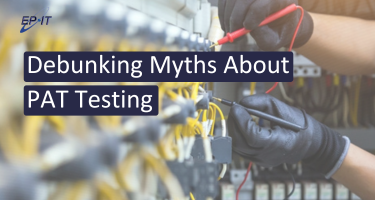 Add My Company
Add My Company

Portable Appliance Testing (PAT testing) plays a critical role in maintaining electrical safety, especially in high-risk environments like the oil and gas industry. However, several myths and misconceptions about PAT testing persist, potentially leading to confusion and unsafe practices. In this blog, we’ll separate fact from fiction to help you understand PAT testing’s role and its limitations.
Myth 1: PAT Testing is a Legal Requirement
Reality: PAT testing itself is not explicitly mandated by law. However, it is widely regarded as the best method to comply with The Electricity at Work Regulations 1989, which require employers to ensure that electrical equipment is safe to use. While there’s no legal stipulation for PAT testing, failing to maintain electrical safety can result in severe consequences.
Myth 2: PAT Testing Must Be Performed Annually
Reality: The frequency of PAT testing depends on various factors, such as the type of appliance, its usage, and the environment it operates in. In high-risk industries like oil and gas, appliances may require more frequent testing due to harsher conditions and greater wear and tear. Conversely, low-risk environments may not need annual tests. A risk-based approach is key.
Myth 3: Only Qualified Electricians Can Perform PAT Testing
Reality: PAT testing doesn’t require a qualified electrician. Any competent individual with the proper training and knowledge of the process can conduct these tests. The key is understanding how to perform the tests correctly and interpret the results accurately to ensure safety.
Myth 4: All Electrical Equipment Must Be Tested
Reality: Not every piece of electrical equipment needs PAT testing. The requirement depends on factors such as the appliance’s class (e.g., Class I or II) and how it is used. For instance, some fixed or battery-operated devices may not need testing, but they should still undergo visual inspections to ensure they are safe.
Myth 5: A PAT Test Guarantees Safety for a Year
Reality: This is a dangerous misconception. A PAT test confirms that an appliance is safe at the time of testing, but faults can develop soon after, particularly in challenging environments like oil and gas facilities. Regular visual inspections and robust maintenance programmes are essential to maintain ongoing safety.
Myth 6: New Appliances Don’t Need PAT Testing
Reality: While new appliances are typically designed to meet safety standards, defects can occur during manufacturing, transport, or installation. Testing new equipment before use ensures it’s safe and fit for purpose, especially in critical applications where failure could have serious consequences.
Myth 7: PAT Testing is Expensive and Time-Consuming
Reality: The cost and time required for PAT testing depend on the scale of operations and the number of appliances. In industries like oil and gas, choosing efficient and cost-effective testing solutions can mitigate these concerns. Investing in proper systems and training can streamline the process and enhance safety without breaking the budget.
Myth 8: Battery-Operated Equipment Needs PAT Testing
Reality: Battery-operated appliances that do not connect to the mains power supply typically do not require PAT testing. However, regular visual checks remain important to identify potential damage or hazards.
Myth 9: PAT Testing Eliminates the Need for Risk Assessments
Reality: PAT testing is just one component of a comprehensive safety strategy. Risk assessments remain essential to identify hazards and implement controls, particularly in high-risk sectors like oil and gas. PAT testing complements these efforts rather than replacing them.
Myth 10: PAT Testing Alone Ensures Complete Electrical Safety
Reality: Relying solely on PAT testing is not enough, especially in environments with high fire and explosion risks. Additional measures such as equipment maintenance, environmental monitoring, and compliance with industry-specific regulations are crucial to ensuring comprehensive electrical safety.
Understanding the realities of PAT testing is crucial for ensuring electrical safety, especially in high-risk industries like oil and gas. If you’re looking to deepen your knowledge or need professional support, EPIT offers a PAT Testing course designed to equip you with the practical skills and confidence to conduct tests effectively. Whether you’re seeking training or expert advice on electrical safety practices, we’re here to help. Don’t leave safety to chance—get in touch with our experts today to book your course or consult our specialists for tailored advice.
For more information on Debunking Myths and Misconceptions About PAT Testing: What You Need to Know talk to EPIT Group
